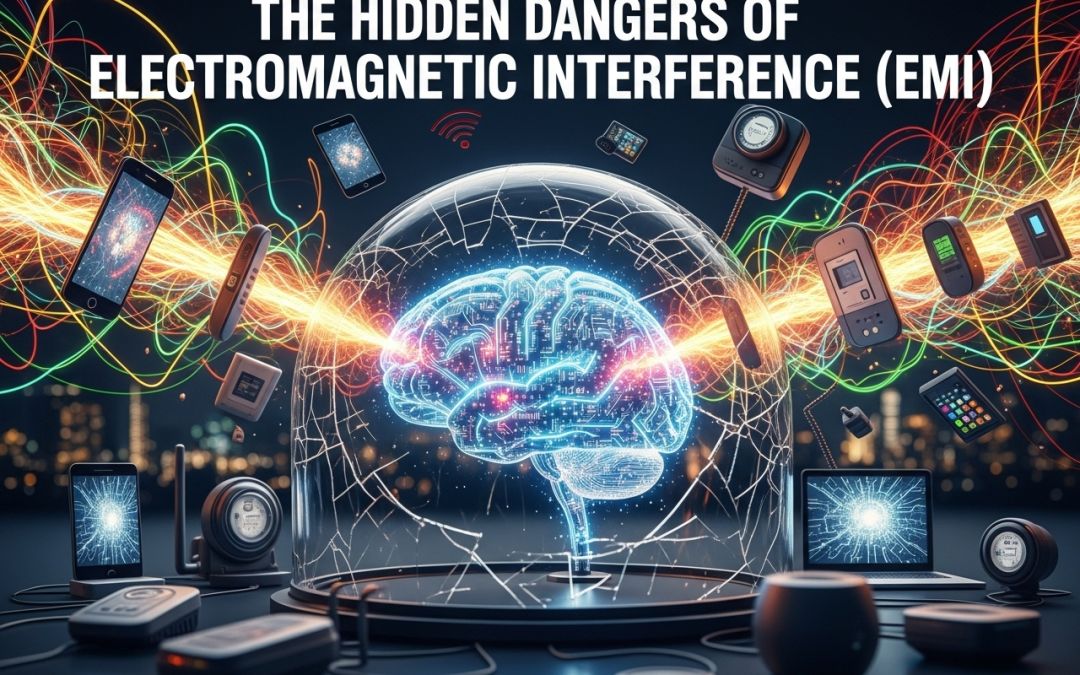In a world that is becoming increasingly interconnected, our homes are inundated with a variety of electronic devices, ranging from smart speakers and Wi-Fi routers to energy-efficient LED lighting. Although these devices are intended to enhance our daily lives, their widespread use has given rise to a subtle yet significant issue: electromagnetic interference (EMI). Commonly known as “electrical noise,” EMI represents an unwelcome disruption that can impair the functionality of sensitive electronic equipment, and for those with expertise, it presents a new challenge in electrical diagnostics.
This article aims to delve into the nature of EMI, identify its prevalent sources within a modern household, examine the potential impacts it may cause, and, most crucially, outline the sophisticated mitigation techniques that an electrician can implement to foster a cleaner and safer electrical environment for their clientele.
What is Electromagnetic Interference (EMI)?
Whenever an electric current passes through a wire, it generates an electromagnetic field around it. Ideally, this field would remain contained and would not influence other devices. Nevertheless, in reality, this energy can ‘leak’ and be detected by adjacent wiring or devices, leading to interference. Electromagnetic Interference (EMI) is fundamentally this electrical noise—unwanted signals that hinder the proper functioning of an electronic device.
There are two main types of EMI:
Conducted EMI: This type of noise propagates through a physical conductor, like a power cord or a data cable. It may originate from malfunctioning appliances or a noisy power supply and is frequently present on the same circuit as the source.
Radiated EMI: This occurs when noise is conveyed through the air in the form of an electromagnetic wave. Nearby device wiring can capture this noise, functioning as an antenna. A typical illustration is the “static” sound you may experience on an AM radio while a blender is operating.
The Unseen Culprits: Common Sources of EMI in the Home
Although large industrial machinery is widely recognized as a significant source of electromagnetic interference (EMI), it is surprising to note that many common household items can also contribute to this issue. The role of an electrician involves pinpointing these sources, which can prove to be difficult due to the often intermittent or subtle nature of the noise.
Common sources of EMI in a home include:
Switching Power Supplies: Numerous contemporary electronic devices—from mobile phone chargers to LED light drivers—utilize switched-mode power supplies. These devices have the potential to generate high-frequency noise that contaminates the electrical wiring within a home.
Dimmer Switches: Traditional, phase-cutting dimmer switches are well-known for producing electrical noise, which may lead to flickering in LEDs or a buzzing sound in audio equipment.Dimmer Switches: Traditional, phase-cutting dimmer switches are well-known for producing electrical noise, which may lead to flickering in LEDs or a buzzing sound in audio equipment.
Appliances with Motors: The motors found in refrigerators, blenders, and vacuum cleaners can produce considerable electrical noise, especially during their startup and shutdown sequences.
Poorly Shielded Cables: When data cables (such as Ethernet or HDMI) lack proper shielding, they may function as antennas, capturing electrical noise from adjacent power lines.
Wi-Fi and Other Wireless Signals: Although this is less of a concern with well-engineered electronics, multiple Wi-Fi access points or other wireless devices located in close proximity can occasionally interfere with one another or with other sensitive electronic devices.
The Impact: Why EMI is a Problem
Smart Home Device Malfunctions: Electromagnetic interference (EMI) may result in smart lights activating and deactivating autonomously, smart locks experiencing failures, or smart thermostats exhibiting erratic behavior.
Data Corruption and Connectivity Issues: Interference has the potential to corrupt data being transmitted across a network, which can lead to dropped Wi-Fi connections, sluggish internet speeds, or data loss on a computer.
Reduced Appliance Lifespan: The persistent “noise” present on a power line can impose stress on the internal components of an appliance, which may ultimately reduce its lifespan.
Inconsistent Performance: A sound system that produces a buzzing noise, a TV screen that flickers, or a computer that unexpectedly freezes could all indicate an issue related to electromagnetic interference (EMI).
The Solution: An Electrician’s Role in EMI Mitigation
The expertise of a professional electrician is invaluable in this context. Unlike a homeowner who may only recognize the symptoms, an electrician is capable of diagnosing the root cause and applying effective mitigation strategies.
Here are some of the advanced techniques an electrician can use to fight EMI:
Effective Grounding and Shielding: A strong grounding system is essential for mitigating electromagnetic interference (EMI). An electrician can verify that the electrical panel of the home and all associated circuits are adequately grounded. During the installation of new wiring, they can employ shielded cables and conduits to physically obstruct electromagnetic fields from impacting other wiring.
Separation of Power and Signal Cables: A key best practice is to keep high-voltage power lines distinct from low-voltage signal cables. If crossing is necessary, it should occur at a 90-degree angle to reduce inductive coupling. An electrician can either reroute current wiring or provide guidance on the appropriate configuration for a new installation.
Installation of EMI Filters: In the case of a recurring EMI issue, a qualified electrician may install specialized filters. These filters can vary from basic ferrite beads (chokes) on individual cables to advanced whole-home or panel-mounted EMI filters. Such devices are engineered to capture and dissipate high-frequency noise prior to its propagation throughout the electrical system.
Isolation and Identification: An electrician can employ a process of elimination to determine the source of the EMI. By methodically turning off circuits or disconnecting devices, they can isolate the problematic component. Additionally, they may utilize specialized tools, such as an EMI meter, to assess the electrical noise across various circuits and accurately identify the issue.
Education and Consultation: The most proficient electricians do not merely resolve issues; they also educate their clients. They can provide guidance to homeowners regarding optimal practices for organizing their electronics, recommend suitable types of bulbs for dimmer switches, and emphasize the significance of using high-quality, adequately shielded cables.
By comprehending and tackling the nuanced yet significant issue of electromagnetic interference, an electrician is able to provide an elevated standard of service. They progress beyond mere wiring and repairs to transform into a genuine consultant regarding a home’s comprehensive electrical well-being, guaranteeing a clean and dependable power supply for a society that relies on it.
Conclusion
As our residences evolve into more intelligent and interconnected spaces, the unseen danger of electromagnetic interference has transitioned from being merely an academic interest to a tangible issue that can undermine the functionality and dependability of our technology. The time of merely ensuring that power reaches an outlet is being replaced by a more advanced requirement: ensuring that the power is clean and devoid of disruptive noise.
By mastering the concepts of EMI, the contemporary electrician transforms their role from a mere wireman to a genuine electrical health expert. They have the expertise to not only repair what is malfunctioning but also to proactively design and safeguard a home’s electrical ecosystem against a threat that many homeowners are unaware of. Through the meticulous routing of cables, the installation of specialized filters, and the essential act of educating clients, the electrician serves as the vital barrier against the concealed risks of a noisy electrical environment. In doing so, they pave the way for a future where our technology operates as intended, our data remains protected, and our homes are supported by a quiet, dependable electrical foundation.

